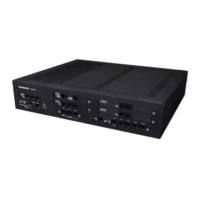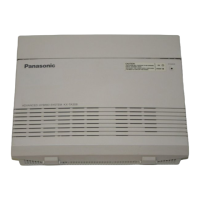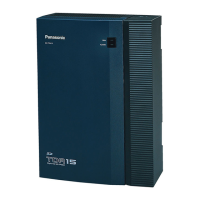1.30.2.2 Common Extension Numbering for Multiple PBXs
Description
Multiple PBXs in separate locations, connected in an IP network, can share a common block of extensions
designated in a gateway group.
Ext. 203
Ext. 202
Ext. 102
Ext. 303
Ext. 201
Ext. 105
Ext. 104
Ext. 103
Ext. 101
PBX B in Office B
1) Ext. 105 dialled
PBX C in Office C
2) Ext. 105 not
found in PBX B
3) Rerouted
4) Check next PBX in
Gateway Group settings
5) Ext. 105
found in PBX C
PBX A in Office A
V-IPGW
V-IPGW
V-IPGW
Private IP
Network
Explanation:
In the same way as when connected by a TIE Line, if a dialled number is not found at the local PBX, the call
can be sent to other PBXs connected via an IP network. When an extension number is dialled, the PBX first
searches local extensions for a matching number. If there is no match, the PBX then checks the TIE Line
Routing Table for the Gateway Group for a corresponding entry. If an entry is found, the call is sent to the
connected PBX.
Conditions
• The KX-NCS4910
or KX-NCS4950 (Activation Key for Software Upgrade to Enhanced Version) is required
to use this feature.
• System programming is required to enable this feature.
• If the called extension does not exist at the called PBX, the next PBX in the same gateway group is called
automatically.
• The Routing to Operator setting in system programming must be disabled to use this feature.
• To use this feature, all PBXs in the IP network have to be KX-TDE series PBXs, version 3.0000 or later.
PC Programming Manual References
12.7 [10-5] Miscellaneous— Intercept—Routing to Operator - No Destination (Destination is not
programmed.)
354 Feature Guide
1.30.2 Voice over Internet Protocol (VoIP) Network

